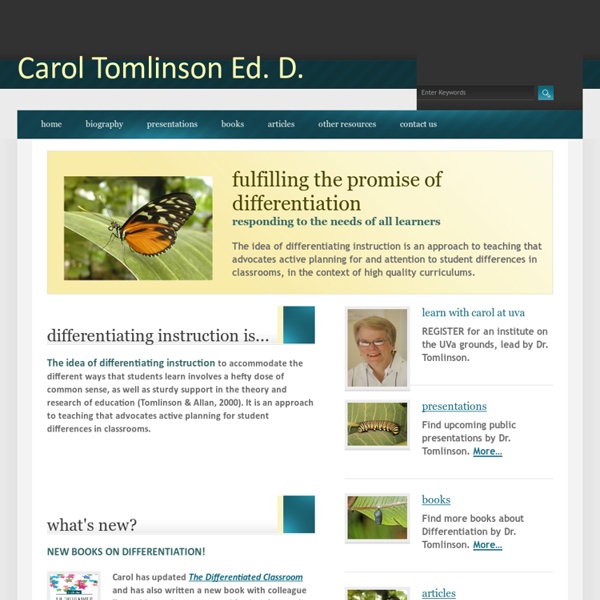



Differentiating Your Classroom with Ease - The Brown Bag Teacher For me, differentiating no longer means creating separate games/activities/learning targets. It doesn't mean that some students do more work or students are being taught different content. It does mean tweaking activities, so they have the just-right scaffolds and pushes for my students. To me - right now - differentiation means... Believing these things, our team has developed structures and organization to help us be intentional in our planning. What do I need? Like most teacher stories, it all starts with school supplies. How do you group and organize for your groups? We flexibly group our friends into these 3 groups - green (below grade-level), yellow (on grade-level), and blue (above grade-level) for math and reading. Color-coding groups really helps with planning and organizing my small-group materials. Right behind my teacher table, I also keep these color-coded bins organized and stocked for Guided Math. What does DI actually look like in your Reading Block?
Making a Difference Published Online: September 10, 2008 Published in Print: September 10, 2008, as Making a Difference Interview Differentiated instruction—the theory that teachers should work to accomodate and build on students' diverse learning needs—is not new. A former elementary school teacher of 21 years (and Virginia Teacher of the Year in 1974), Carol Ann Tomlinson has written more than 200 articles, chapters, and books, including The Differentiated Classroom: Responding to the Needs of All Learners and Fulfilling the Promise of the Differentiated Classroom: Strategies and Tools for Responsive Teaching. Anthony Rebora, editorial director of the Sourcebook, recently talked to Tomlinson about the theory of differentiated instruction and its use in schools today. —Photo by Jay Paul Differentiated instruction is a term that is interpreted in a lot of different ways. As I see it, there are three ways to deal with students’ differences. What are the hallmarks of a well-run differentiated classroom?
DI: Success for Every Student Teachers all over the United States are seeking new and better ways to meet the needs of all of their students so that they can reach their full potential and be successful academically. The "No Child Left Behind Act" signed into law in 2002 has created an even more compelling reason for teachers to take a closer look at their teaching practices. The focus of this law is to close the achievement gaps between different groups of students. Implementing the concepts and principles of differentiated instruction is one way to begin closing this gap. get started now Lesson 1: Differentiated Instruction at a Glance (Flash required) Differentiated instruction is not a new idea in education. Curriculum Associates is offering this course to help you as a teacher bring differentiated instruction into your classroom. Each lesson includes text and audio instruction, examples, handouts, a reading assignment, and a lesson review with which you can assess your own learning progress.
Differentiation | Teaching AC English Differentiating teaching and learning requires knowledge of each student’s background and experiences, interests, readiness and learning needs. Teachers use this knowledge to plan and implement curriculum, teaching strategies, learning experiences and assessments that provide multiple pathways for learning for every student. This ensures all students have equitable access to curriculum and are able to demonstrate success. Knowing your students is the key to differentiating teaching and learning – what they know and can do, what they need to learn next and how best to teach them and monitor their progress. The Australian Curriculum is shaped by the proposition that each student can learn and that every student’s needs are important. The aspects of differentiation represented in these vignettes include:
Home 7 Neuroscience Fundamentals For Instructional Designers - eLearning Industry The brain is a beautiful thing. It's also one of the most complex and complicated structures known to man. Every emotion, thought, and memory involves countless chemical reactions and neural pathways. To learn new information, our minds must be primed for the task. Which is why eLearning professionals should consider these 7 neuroscience fundamentals for their Instructional Design. 1. Our brains are often likened to machines. 2. Learning isn't as simple and straightforward as some might think. 3. The human memory is finite. 4. It probably comes as no surprise that humans love rewards. 5. Everyone needs a bit of personalized praise from time to time. 6. It's a known fact that stress wreaks havoc on the body. 7. Joyful and positive eLearning experiences are more memorable. These neuroscience fundamentals give you the opportunity to create personalized eLearning courses that motivate, inspire, and engage your online learners. Would you like to learn more about the psychology of learning?
Differentiated Instruction and Universal Design for Learning NCTM News Bulletin (April 2008) by Nancy Berkas and Cyntha Pattison Planning differentiated mathematics lessons requires a fundamental understanding of the mathematics content. However, understanding content is not enough by itself to address the needs of every student. It is important to understand the possibilities and ramifications of the research related to the response to intervention (RTI) model. RTI, or a similar model that redistributes the responsibility for the learning of every student to the classroom teacher, calls for highly knowledgeable educators who spend as much time planning as they do facilitating or teaching the core lessons. Not all students are alike. Rose and Meyer (2002) note that UDL is a new approach to curriculum—goals, materials, methods, and assessment—that rests on the belief that every learner is unique and brings different strengths and weaknesses to the classroom. The UDL framework establishes three References Hitchcock, Chuck, Anne Meyer, David H.
DI: What's it all about? Video resources